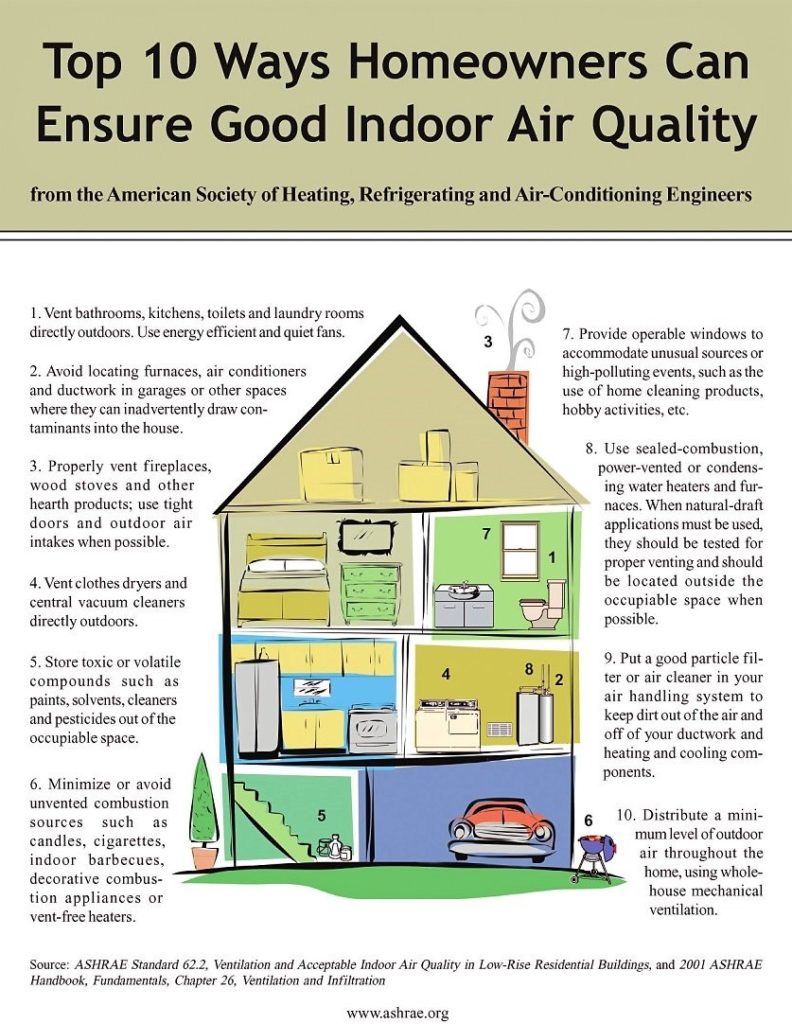
Home Remedies: Indoor Air Quality
When we think of air pollution, we usually think of smog. But the air indoors is not always as clean as we think. And as the cold weather pushes people indoors, the air inside our homes is the air we breathe the most. In a pandemic year, the quality of indoor air takes on even greater importance than usual.
Why IAQ?
Indoor air quality (IAQ) has a direct and immediate impact on our health. The World Health Organization reports that 92% of the world’s population breathes in sub-standard air, with 3.5 million deaths attributed to indoor air pollution each year. Globally, the main cause of indoor air pollution is burning solid fuel for heating and cooking. In wealthy nations, indoor air quality is becoming a bigger problem as people are spending more time indoors in homes that are built “tighter” for energy efficiency.
Indoor air quality can be two to five times worse than outside air quality. That’s especially troubling because multiple studies show that people spend between 80% to 90% of their time indoors. Approximately 65% of that time is in the home.
IAQ Problems
Poor IAQ aggravates allergies and asthma. But indoor air pollution can have other direct effects, appearing immediately upon exposure or building over the long term. Immediate symptoms can resemble the cold or flu, while long-term effects can include some respiratory diseases, heart disease, and cancer. A Harvard study found that improved indoor air quality doubled occupants’ cognitive function test scores.
While the impacts of poor IAQ are myriad, there are three strategies for improving indoor air quality: source control, ventilation improvements, and air cleaners.
Source Control
Indoor air contaminants can originate within the building or enter from outdoors. Carbon monoxide can be released by fuel-burning appliances like furnaces and fireplaces. Many cleaning products, solvents, glues, and paints can release volatile organic compounds (VOCs). Homes built before the 1990s may still contain asbestos. Lead paint from as late as the 1970s could still be generating lead dust in the home. Even the products you use to make the air in your home smell cleaner can be pollutants. Commercial air fresheners often contain dangerous VOCs, and smoke from candles and incense is chemically similar to wood smoke.
Outdoor pollutants can also make their way into the home. Recent years have taught us to close up our houses during smoke storms. Nearly one in 15 homes in the U.S. have elevated levels of radon, a radioactive gas generated naturally in the soil that enters the house from the ground. Even moisture can be a pollutant indoors, encouraging the growth of mold, mildew, and mites and accelerating off-gassing as wet materials like windowsills and furniture deteriorate.
Testing can identify significant pollutants in your home. But even without testing, source control is the first line of defense. Deal with old materials like asbestos and lead paint; minimize combustion inside the home; and carefully screen household products and cleaners for VOCs. The asthma & allergy friendly® Certification Program helps you find products that have been independently tested in labs and proven to remove or reduce your exposure to asthma and allergy triggers,
Ventilation Improvements
Energy efficiency is important to fight climate change, but good ventilation is important for health (and can help reduce the spread of COVID indoors. EPA developed Energy Savings Plus Health: Indoor Air Quality Guidelines for Single-Family Renovations to provide practical guidance on indoor environmental quality during energy-efficient renovations.
Keeping doors and windows open is the simplest and most effective way to ventilate your home. But in most climates, that’s not an option in the winter. Most home heating and cooling systems do not mechanically bring fresh air into the house, but regularly cleaning filters and ducts will keep airflow high and reduce the particulates cycling in the house. Although HVAC filters are not enough to protect inhabitants from COVID, they can somewhat reduce the viral load of indoor air.
Some newer systems bring outdoor air into the home with energy-efficient heat recovery ventilators (also called air-to-air heat exchangers). You can also make a difference by using bathroom and kitchen exhaust fans.
Air Cleaners
Air cleaners are not designed to remove gaseous pollutants, and many, especially the tabletop variety, are not very effective at particle removal either. The most effective air purifiers have both a high percentage efficiency rate (how well it collects pollutants) and high airflow (expressed in cubic feet per minute). In combination with other measures, air purifiers can help reduce airborne contaminants, including viruses.
While houseplants do technically purify air, they have not been shown to make a significant difference to home IAQ, and can even aggravate allergies when overwatered.

Through a combination of source control, ventilation, and air cleaners, you can achieve high indoor air quality in your home.
Originally published on November 15, 2021, this article was updated in January, 2023.